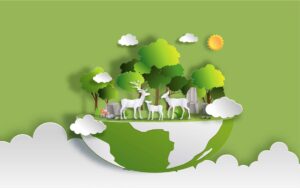What is Living World?
When we try to define ‘living, or Living World’ we conventionally look for distinctive characteristics exhibited by living organisms. Growth, reproduction, ability to sense the environment and mount a suitable response come to our mind immediately as unique features of living organisms. One can add a few more features like metabolism, ability to self-replicate, self-organize, interact, and emergence to this list.
Salient features of living entities:
Growth- Increase in mass, increase in no of an individual in plants, continuous, animals- certain age. Unicellular- cell division. Non-living-accumulation of material on the surface. Not a defining feature.
Reproduction- Production of progeny possessing features more or less similar to parents. Can’t reproduce – mules, Worker bee, sterile. Not a defining characteristic.
Metabolism – Sum of all chemical reactions, not shown by non- living. Isolated reaction outside the body (test tube)- neither living nor non-living. Defining feature.
Consciousness- Ability to sense and respond to environmental change. Animals – sense organs; Plant- geotropism, phototropism.
Coma patient – by machines replacing heart & lungs, no self-consciousness. Not a defining feature.
Click Here for Complete Biology Notes
Diversity in Living World:
Biodiversity- Number & type of organism on Earth. (1.7 – 1.8 million)
Nomenclature – Naming organisms such that the same name knows it all over the world.
ICBN- International Code for Botanical Nomenclature.
ICZN- International Code for Zoological Nomenclature.
ICVN- International Code for Virus Nomenclature.
ICNCP- International Code of Nomenclature for Cultivated Plants
Identification – Ability to know to what organism name attached to.
Binomial Nomenclature – Name to organism with 2 – components. (Carolus Linnaeus), have a generic name + specific epithet.
Rules-
- In Latin, written in Italics.
- In handwritten- underlined/printed in italics
- The first word starts with a capital letter, second small letter
Author name after specific epithet, Mangifera indica Linn Classification – Grouping of organisms in categories.
Taxonomy – Classifying organisms in various taxa.
Classification, identification, characterization, nomenclature.
Systematics – Systema – (Latin) systematic; arrangement of organism.
Carolus – ‘Systema Naturae’
Taxonomic Categories – Kingdom, Phylum/Division, Class, Order, Family, Genus, Species. All categories constitute a hierarchy.
Taxa – Each category (unit of classification) representing rank.
| Father of Indian Taxonomy | H Santapau |
| Father of Indian Botany and Indian Herbaria | William Roxburgh |
| Term ‘taxonomy’ coined by | A.P. de Candolle (French botanist)
Book- Théorie élémentaire de la Botanique |
| Father of Taxonomy | Carolus Linnaeus |
| Dynamic concept stating species is dynamic and mutable | Lamarck |
| Biological concept of species | Dobzhansky and Mayr |
Species – Group of individuals with fundamental similarities.
E.g.- Indica, tuberosum, leo
Genus – Group of related Species. E.g.-Solanum, Panthera
Family – Group of related genera. E.g.- Solanaceae, Liliaceae
Order – Group of related families. E.g.- Carnivora, Primata
Class- Related orders. E.g., Mammalia, Insecta.
Phylum – Related class. (Presence of notochord & dorsal hollow neutral system) e.g., Chordata, Arthropoda.
Kingdom – Related phylum, e.g., Animalia, Plantae
Lower taxa, more characteristic members within taxon share
Taxonomical aid- Procedures and techniques to store & preserve information & specimens.
Herbarium – Herb – plants, arium – protecting place.
- Storehouse of plant specimens- dried, pressed, preserved in sheet, morphological study, difficult to maintain, carry data, place of collection, local, botanical name, family, collector name.
Botanical garden – Collection of living plants
- Grown for identification, morphological & anatomical study.
- A tree can be preserved as whole.
- E.g., Indian Botanical Garden (Howrah), National Botanical Garden (Lucknow), Royal Botanical Garden (Kew, England)
Museums – Both plants and animals are kept preserved.
- The morphological study, extinct or endangered species are also kept, preserved in formalin solution; insects are preserved after collecting, killing, pinning.
Zoological park- For animals, kept for observation, cared by humans, a condition similar to natural habitat, characters observed- food habits, gestation period, etc. e.g.- Jim Corbet, Gir.
Key – Identification of plants and animals on similarities and dissimilarities, based on contrasting character, so in pairs-couplet. Each statement in key- lead, analytical in Nature.
Flora- Distribution of plants in particular area.
Manual – Identification of names of species in an area, book containing complete listing of plants.
Monograph – Information of any 1 taxon.
Catalogue- Alphabetical arrangement of species of particular place describing features.

